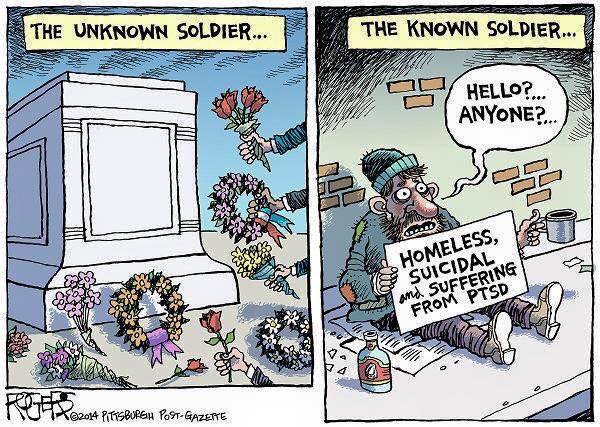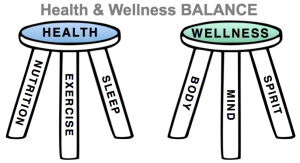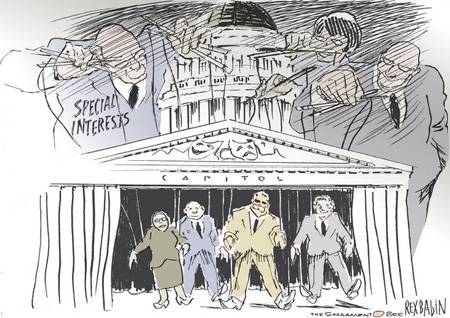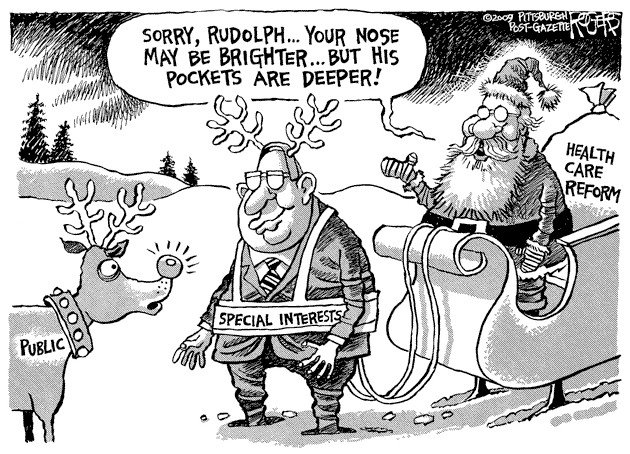Healthcare Special Interests versus Public Interests
Is it just “One Step Forward and Two Steps Back?” or is something bigger happening?
This post was inspired by a Huffington Post article by Charles Francis. It addressed the issue of public interests versus special interests, and here I’ll extend that question to healthcare special interests reflecting on the progress consumers are making despite politicians working against them. But first, more on the obstacles we face.
Francis examined the need to change consumer behavior toward healthier lifestyles, causing me to think about the role of incentives and awareness education. But I’ve written about that before, and today I’ll take a broader look at the many factors influencing the health and productivity of our nation’s workforce. I remain guardedly optimistic that we’ll overcome political corruption and will share why. Included are links to many related articles and this list of past articles on healthcare policy.
Predicting the Future is a complex art.
I’ve said before that futurists don’t just extrapolate trends; they also look at drivers & inhibitors and help organizations craft plans toward a “preferred” future. That’s why it’s important to check underlying currents and ask the bigger question, “What sort of nation do we WANT to be when we grow up?” After all, we’re arguably still progressing toward a more-perfect union.
As we contrast Healthcare Special Interests versus Public Interests, we also must also ask, “Is healthcare a human right or a privilege?” because the answer to that question helps us decide the best way forward. Our collective answers, however, are influenced by how the issues are framed in the media, and by politicians we listen to.
Framing the Public Interest Issues

As shown in the cartoon, how the media, marketers, and politicians present, or “frame,” an issue or story, and whether it’s even covered it at all, largely influences public opinion and our moral evaluation of it. That’s why news media consolidation and selective Internet filtering (“if you liked that, then you’ll like this too”) is so dangerous. If we get our news from just one source, we only get one perspective and tend to live in a bubble.
Media Consolidation
Today just 6 large corporations control a staggering 90% of media (TV, radio, movies, and print), as shown in the infographic at the bottom of this article. And, they each have a legal responsibility to serve the investment interests of shareholders rather than public interests.
- GE owns Comcast, NMC, and Universal Pictures;
- News-Corp owns Fox, Wall Street Journal, and New York Post;
- Disney owns ANC, ESPN, Pixar, Miramax, and Marvel Studios;
- Viacom owns MTV, BET, and Paramount Pictures;
- Time Warner owns CNN, HBO, TIME, and Warner Brothers; and
- CBS owns Showtime, Smithsonian Channel, NFL.com, and 60 minutes.
On the political side of news filtering, Republicans are naturally drawn to Fox News and The Wall Street Journal while Democrats are attracted by MSNBC. That’s because those news outlets reinforce their audience’s ideology and moral judgment. But that also means they contribute to the political polarization of Congress and attract advertisers that also help steer their framing message.
The Corrupting Influence of Big Money in Politics (and advertising)
The upcoming election cycle promises to be the most expensive and divisive in history, thanks largely to the Supreme Court’s disastrous Citizens United ruling, the gerrymandering of voting districts, and Republican attempts to shape the voting populace by tightening rules in a way that disproportionately affects undesirable voter blocks.
Most politicians, even those on the right, complain about an electoral process that forces them to spend so much time fundraising and gives them the appearance of being beholden to large campaign donors and lobbyists, at least publicly. Privately, however, they like the money and power this provides, so they’re unlikely to vote for term limits or campaign finance reform.
In another cartoon, a little boy asks his mom, “Why do we have wars?” Mom answers, “Because we are ruled by an elite group of psychopaths who own the banks that control the governments and media. They fund both sides of war for profit, and they manufacture the consent of the public through the propaganda of the media.” (That’s more true than funny.)
Big Money from Healthcare won’t work much longer
 As Steven Brill wrote in his 38-page TIME special report, A Bitter Pill: Why High Medical Bills Are Killing Us, the medical industrial complex (hospitals, drug companies, insurance companies, testing companies, and equipment providers) spends three times as much on political lobbying as the military industrial complex. That’s because they know that 429 of the original Fortune 500 companies [1955] are no longer in business today, and if history is our guide, some 86% of these 45 healthcare companies (from the 2014 Fortune 500) are doomed to obscurity or worse if they don’t adjust to the forces of healthcare reform. They also know that the ROI from political influence is higher than almost any other investment they can make.
As Steven Brill wrote in his 38-page TIME special report, A Bitter Pill: Why High Medical Bills Are Killing Us, the medical industrial complex (hospitals, drug companies, insurance companies, testing companies, and equipment providers) spends three times as much on political lobbying as the military industrial complex. That’s because they know that 429 of the original Fortune 500 companies [1955] are no longer in business today, and if history is our guide, some 86% of these 45 healthcare companies (from the 2014 Fortune 500) are doomed to obscurity or worse if they don’t adjust to the forces of healthcare reform. They also know that the ROI from political influence is higher than almost any other investment they can make.
The Medical Industrial Complex
- Pharmaceutical: J&J, Pfizer, Merck, Eli Lilly, Abbvie, Amgen, Bristol Myers Squibb, Gilead, Biogen Mylan, Celgene, Allergan
- Insurance: United, WellPoint (Anthem), Aetna, Humana, Cigna, Centene, HealthNet, WellCare, Molina Healthcare
- Services: HCA, Community Health Systems, Tenet, DaVita Healthcare Partners, Universal Health Services, Vanguard Health, Kindred Healthcare, Express Scripts, Quest Diagnostics, Omnicare, LabCorp of America, Quintiles
- Medical Products: Abbott, Medtronic, Baxter, Stryker, Becton Dickinson, Boston Scientific, St. Jude
- Wholesalers: McKesson, Cardinal, AmeriSource Bergen, Henry Schein, Owens & Minor
Some of the actions of this medical industrial complex make our healthcare system seem evil, and political corruption from their lobbying efforts may be the biggest reason for despair, but I still remain optimistic. That’s because we live in a democratic society, and I have more trust in humanity than most. Even if the political system is corrupted, and this medical cartel can justify spending $1 trillion in one election cycle to avoid losing $2 trillion/year in health reform, we still have the power to vote. But we must become well-informed voters and seek truth no matter how the issues are framed and presented in the media.
Excessive greed (evil?) seems natural for an industry that:
- profits more from illness & injury than from wellness;
- gets over $4 trillion/year from people spending twice as much on healthcare as other nations, but who still live sicker and die younger;
- spent more lobbying in Washington than the defense and aerospace industries and the oil and gas corporations combined;
- views patients as paying customers and works to keep them (paying);
- trains new docs to diagnose illness and treat symptoms, with almost no training on prevention or the pillars of health: nutrition, exercise and sleep;
- lacks the financial incentive to invest in prevention, health, and wellness and instead compensates providers with a fee-for-service payment model that encourages over-testing, over-prescribing, and over-treating;
- publishes academic papers written to defend their gravy train and to attack potential competitors that get to the root cause of problems to avoid the need for medical care in the first place; and
- generates artificial demand by advertising drugs, scooters, and medical devices directly to consumers, with a call-to-action of, “ask your doctor.”
Contrasting Motives: Private Sector versus Public Sector
No one seems to like paying taxes, but taxes are used to fund important public investments in things like national security, public safety, education, healthcare, housing, infrastructure, basic research, sustainability, and more. The big question when deciding how much to tax and spend is, “What’s the proper role and size of government?” That’s where it’s helpful to get past political ideology influenced by income inequality and instead look at the question objectively.
 When writing about health reform, I’ve often said the key is getting the incentives right. That means eventually getting private insurance companies out of BASIC health care entirely, because their profit motive leaves no lasting incentive to cut costs. After all, higher costs eventually lead to more insurance customers paying higher premiums.
When writing about health reform, I’ve often said the key is getting the incentives right. That means eventually getting private insurance companies out of BASIC health care entirely, because their profit motive leaves no lasting incentive to cut costs. After all, higher costs eventually lead to more insurance customers paying higher premiums.
Several years ago I proposed an alternative hybrid public/private model designed to (1) capitalize on contrasting incentives, (2) end the need for health insurance, (3) cut healthcare costs in half, and (4) save over $2 trillion per year.
The premise of my argument was that in a free-market society, private companies are most efficient when there’s vibrant competition on a level playing field, because that competition causes them to take risks, invest, improve service & product quality, and drive down prices. These private companies, answering to shareholders and driven by profit motives, measure success in business terms such as Revenue, ROI, and Payback Period. All that is good for capitalism, but it encourages short-term thinking based on quarterly stock performance. And some will argue that capitalism as we knew it, is broken.
In contrast, public entities measure success very differently and over much longer time periods, meaning they can make more strategic and longer-term investments in things like sea and airports, interstate highway systems, and utilities; and they can fund them with bonds and tax revenues. Their goals might focus on things like lifestyle improvements; on nurturing a skilled, healthy and productive workforce; and on infrastructure as the engine of economic growth to benefit all. The point is that governments are better at investing long-term.
Some people see public services as generally having large and inefficient bureaucracies, but the public sector can actually be more cost-effective with no need to make a profit, and their relatively large size is due mostly to the scale of their operations. An example of that is Medicare, which has much lower administrative costs and is reported to have done a better job of controlling costs than the private sector. That’s why so many on the left call for a universal healthcare system based on Medicare-for-All while some on the right still question the facts and call for cutting Medicare and Medicaid entirely.
The Evolving Nature of Healthcare Special Interest Reform
Even though incumbent providers resist disruptive change, the need and benefits of health reform are just too great to ignore, and public pressure is causing a shift in the political winds, driven by dozens (or hundreds) over overlapping trends and MiniTrends. In my view, significant health reform is an economic and social imperative and will certainly happen sooner than most people expect.
Drivers of Health Reform
Aging Boomers – Globally, the population is getting older and needing more care, stressing social systems and leaving fewer young workers to fund the government and care for the elderly. To make matters worse, tech innovation is having a profound effect on longevity, allowing people to live longer than in past generations, and that trend will accelerate. [Oh yes, but while people in other rich nations are living longer, longevity in the U.S. has been declining in the last several years.]
Unsustainable Costs – While the rate of spending increase leveled off some with Obamacare, healthcare still consumes 18% of GDP; and that share is projected to rise with unsustainable impacts on national debt and family income, simply because of demographics.
Huge Potential – The $4 trillion/year that Americans pay for healthcare is twice what other advanced nations pay, but we still live sicker and die younger, according to The Commonwealth Fund. So theoretically, with all of our technology and ingenuity, we should be able to cut spending in half while still improving care, and leaving $2 trillion to spend elsewhere on tax deductions, the national debt, or economic development with investments like education and healthcare for a more productive workforce.

Wellness – In medical school, new doctors are taught to diagnose and treat illness, thus supporting the profit motive of a “sick care” system rather than a health and wellness system. They’re taught very little about the pillars of health – nutrition, exercise and sleep – but I think that will change. Most doctors I’ve spoken to are frustrated with the current system and don’t have enough face time with patients because of how they’re paid. Some of them are seeking new business models that better fit why they got into medicine in the first place – to help people. Those new models include Functional Medicine, Telemedicine, and Concierge Clinics, among others.
Transparency – While Obamacare didn’t eliminate the need for private health insurance and indeed put more people into insurance programs, it was able to affect positive change within the insurance model. It prevents insurers from denying coverage for people with preexisting conditions or cutting them off when their care gets expensive. An 80/20 rule now requires them to pay 80% of premiums on medical care and not on marketing, administration, and profit. And insurance exchanges make it easier for the public to make apples-v-apples comparisons of insurance policy options.
As a result, insurers are beginning to replace prepaid medical care with policies that give consumers more skin in the game with high deductibles while protecting them against devastating financial loss from catastrophic illness or injury. They’re putting pressure on providers to disclose charges ahead of time so consumers can comparison shop for the best value in care options. And they’re taking wellness programs developed for self-insured corporations and offering them to everyone with the goal of lowering costs by keeping people healthy.
Disappearing Group Plans – Because consumers can now buy health insurance on their own through exchanges, I expect to see less & less dependence on employer-provided group plans, thus giving workers more coverage choices than ever before. I support changes in the law that would encourage companies to pay for insurance that employees find on their own and not providing it for them. That change would make it easier for workers to seek better jobs elsewhere without worrying about health care, and it would put more pressure on employers to offer more competitive wages and benefits.
Tech Innovation – The pace of innovation has evolved exponentially ever since Intel’s Gordon Moore coined the term, Moore’s Law, and these technologies are finally bringing disruptive change to healthcare business models. As medical devices keep getting smaller, cheaper, more accurate, and easier to use, for example, they enable many functions done by physicians in hospitals to move down-market to nurses in retail clinics and moms at home.
Overlapping MiniTrends – Some of the biggest opportunities for disruptive change come from the overlap of relatively unnoticed (or ignored) MiniTrends. Examples include the continuous monitoring of sensor data from wearable devices, remote telehealth video calls, healthcare robots, big data analysis, and artificial intelligence designed to turn mountains of information into knowledge and actionable insight, as characterized by IBM’s Watson.
The Quantified Self-Help Movement
 Even though America has an obesity epidemic, I’m encouraged by consumers becoming more aware of the need to make better lifestyle decisions because of how that affects their health, performance, and wealth. With that trend has come digital sensors, activity trackers, and the Quantified Self movement (watch the video), along with an increased desire for balance.
Even though America has an obesity epidemic, I’m encouraged by consumers becoming more aware of the need to make better lifestyle decisions because of how that affects their health, performance, and wealth. With that trend has come digital sensors, activity trackers, and the Quantified Self movement (watch the video), along with an increased desire for balance.
Arianna Huffington has been a champion of that cause. In her book, THRIVE, she challenges the old definition of success being money and power and stresses the need for a balanced Third Metric that prioritizes mindfulness and sleep. Executives everywhere are starting to buy into her message and are describing their own performance benefits from sleep wellness and meditation.
Wellness as an Alternative Future
From what we hear in the media or see in the movies, the future of healthcare might look bleak if we’re inclined to look for the bad in things. But take these documentaries as examples since their aim is to prompt change:
“Escape Fire: The Fight to Rescue America’s Healthcare” is like “An Inconvenient Truth” for the healthcare debate, presenting our current path as unacceptable so we’ll commit to changing it.
“The Weight of the Nation” is a four-part HBO documentary about America’s uphill battle with obesity, intended to focus our attention on nutrition and wellness.
“A Place at the Table” is about the serious economic, social, health and cultural implications of poverty.
“The Corporation” describes the curious history, inner workings, controversial impacts and possible futures of the corporation as a legal entity.
Contrast the different perspectives Pixar’s Wall-E and Robot and Frank. “Wall-E” is a critical but warm-hearted commentary on environmental pollution where future humans are portrayed as super-obese couch potatoes. On the other hand, “Robot and Frank” shows the benefits of companion robots, even for those who don’t quickly warm to technology.
Whether apocalyptic or aspirational, we don’t always have to accept what’s presented as our fate, because as humans living in a democracy, we can choose a different destiny.
Sleep Wellness as a New Frontier
From my past as a retired IBM systems engineer and market strategist, I’m drawn to the really big “IBM-scale” problems, like the rising healthcare costs, as well as exploring the underlying causes to find solutions. With benefits measured in hundreds of billions of dollars, any influence I can have will be meaningful.
Sleep wellness fits that description because of its direct link to all sorts of health conditions, longevity, safety, and performance – at school, work and in sports. That’s why I’m working with the consultants at Intelligent Sleep here in Austin to evolve the idea of Population Sleep Wellness. Keep a watch for a white paper I’m writing on that topic, which aims to encourage sleep as a national priority through both the public and private sectors.
The Problem – Nearly half of all working adults don’t get enough sleep on a regular basis, and over 65% of adolescents don’t. So with its health impact, the CDC has described sleep deficiency as “a public health epidemic.” Apparently the $32 billion sleep industry, which ranges from mattress retail (>12B) to sleep medicine & prescription drugs (>$12B), is not working, so not only do we see a tremendous unfilled need but an immense business opportunity.
The Opportunity – Sleep Wellness has the potential to grow to a $100B industry in 10 years on its own, following a similar path as the fitness and weight-loss industries. The fitness industry itself has annual revenues of over $100B, but it hardly existed at all in 1970. It didn’t really take off until public awareness caught up with scientific understanding, thanks largely to Dr. Kenneth Cooper who coined the term Aerobics and tied it to heart health.
Weight loss is another $100B industry that didn’t exist in 1970, and a big driver in that growth was Weight Watchers, because it provided a social support system that made it easier for people to change their habits. Intelligent Sleep is creating programs to provide a similar support system with consultants who serve as personal trainers for sleep & brain health, and regular meetings locally and online.
So back to the question, “Is it just ‘One Step Forward and Two Steps Back?’ or is something bigger happening?” I think it’s something bigger – an increased focus on wellness among consumers, corporations, and public officials; an intense dissatisfaction with the divisive and corrupted political process; and citizens finally motivated enough to do something about it. What do you think?
I urge you to comment on this article and to get informed and cast your vote as part of the solution, because special interests don’t represent YOUR interests.
The Infographic
ABOUT THE AUTHOR
Wayne Caswell is a retired IBM technologist, futurist, market strategist, consumer advocate, sleep economist, and founding editor of Modern Health Talk. With international leadership experience developing wireless networks, sensors, and smart home technologies, he’s been an advocate for Big Broadband and fiber-to-the-home while also enjoying success lobbying for consumers. Wayne leans left to support progressive policies but considers himself politically independent. (contact & BIO)





